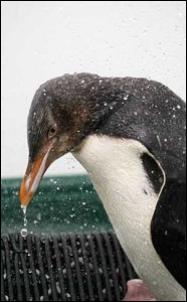
Hoiho on mend after a little R&R at wildlife ward
http://www.scoop.co.nz/stories/SC0809/S00040.htmThursday, September 11, 2008
One of the world’s rarest penguins has enjoyed a three-week stay at the University’s wildlife ward. After almost doubling its arrival weight, a young adult Hoiho (yellow–eyed penguin) is to return to Otago tomorrow and, hopefully, find a mate.Wildlife vet Dr Roberto Aguilar says the penguin was found extremely emaciated on the Wellington coast. It was initially cared for cared for by the Native Bird Rescue Wellington Trust and was then moved to Massey’s specialist wildlife facility.
“It was a young adult and whether it had swam or followed a wrong current it was very thin and extremely dehydrated. It was doing what we call hock-sitting, where it is unable to stand up properly,” Dr Aguilar says.
Yellow-–eyed penguins are a true sub-Antarctic species, Dr Aguilar says, and the penguin was either lost or at the very least wandering to have arrived at the North Island. Staff at the wildlife ward, which is sponsored by Shell New Zealand, did the usual medical tests but found nothing other than some parasites.
“We treated those and short of being debilitated there was nothing else wrong,” Dr Aguilar says. “It may just have had what we call mal-adaption, that is he just didn’t know how to survive properly without access to proper food.
“We started feeding it, making sure it got enough energy and it started coming around pretty fast. It has gone from 3.5kg to 5.3kg and it’s gaining about 100g a day. It now looks pudgy, which is good because it’s the fat store that protects them from the environment.”
Although it is not known whether the penguin is male or female, it is being sent back to the Otago Peninsula early tomorrow, so that it will be able to find a mate.
Department of Conservation programme manager David Agnew says the penguin will be taken straight to a site where there are no dogs and the area is bordered by public conservation land.
“We will just let it go on the edge of the vegetation and allow it find its feet – find its way into the sea to fish when it is ready,” Mr Agnew says.
He says there are about 470 breeding pairs in the South Island, with the rest of the 6000-7000 population on Stewart and the sub-Antarctic islands. The penguin will be tagged so that if it is picked up again by the department its history will be available.
The penguin is named for its distinctive yellow headband and yellow iris, with the Maori name hoiho referring to its shrill call. Some hoiho can live until their 20s, with the birds reaching 65 cm and 5.5kg.


















No comments:
Post a Comment